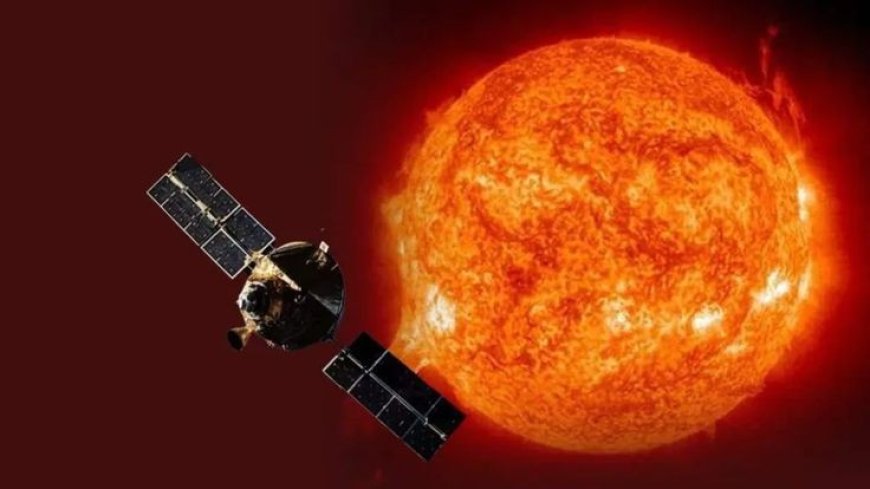Aditya-L1: India's Pioneering Journey to Unravel the Mysteries of the Solar Corona
In the vast expanse of our solar system, a remarkable mission is set to rewrite the way we harness the power of the sun. Named after the radiant sun god Aditya, India's Aditya-L1 mission is a testament to human ingenuity and our unending quest to unravel the mysteries of the cosmos. This blog is your gateway to understanding the ground breaking mission, Aditya-L1, and its profound implications for our world. For more information read full article by examrewards.com

Aditya-L1: India's Pioneering Journey to Unravel the Mysteries of the Solar Corona
In the vast expanse of our solar system, a remarkable mission is set to rewrite the way we harness the power of the sun. Named after the radiant sun god Aditya, India's Aditya-L1 mission is a testament to human ingenuity and our unending quest to unravel the mysteries of the cosmos. This blog is your gateway to understanding the ground breaking mission, Aditya-L1, and its profound implications for our world. For more information read full article by examrewards.com
TABLE OF CONTENT :-
· Introduction
· Aditya-L1 Objectives
· Cutting-Edge Technology
· The Significance of Aditya-L1
· Challenges and Future Prospects
· Conclusion
The Aditya-L1 mission, spearheaded by the Indian Space Research Organisation (ISRO), is an extraordinary scientific endeavor that aims to uncover the secrets of our closest celestial neighbor, the Sun. Named after Aditya, the Hindu Sun god, this mission is set to explore the outermost layer of the Sun's atmosphere, known as the solar corona. In this in-depth exploration, we will embark on a unique journey through the Aditya-L1 mission, its multifaceted objectives, its profound significance, and the cutting-edge technology that powers it.
Aditya-L1 Objectives: Peering into the Solar Heart
The Sun, a burning cosmic furnace at the center of our solar system, has captivated the human imagination for centuries. However, despite its proximity, the Sun's outer atmosphere, the solar corona, remains shrouded in mystery. The corona's temperature surpasses that of the Sun's surface, a perplexing enigma termed the "solar corona heating problem." Aditya-L1 was conceived to address this and many other enigmas surrounding our celestial partner.
Unlocking Solar Corona Mysteries: The primary mission objective of Aditya-L1 is to conduct an extensive study of the solar corona. By scrutinizing the corona's behavior, temperature variations, and magnetic field dynamics, scientists hope to unravel the long-standing mystery of why it is hotter than the Sun's surface.
Solar Wind Insights: Solar wind, a continuous stream of charged particles emitted by the Sun, plays a crucial role in our solar system. Aditya-L1 seeks to fathom the origins and acceleration mechanisms of these particles, as they can significantly impact Earth's space weather.
Space Weather Forecasting: Solar activities, such as solar flares and coronal mass ejections, have the potential to disrupt satellite communication, navigation systems, and power grids on Earth. Aditya-L1's data will contribute to the development of advanced space weather forecasting, thereby helping mitigate their adverse effects on our technology-dependent society.
Exploring the Sun-Earth Connection: The Sun and Earth are intricately linked in various ways, influencing our planet's climatic patterns and even human health. The Aditya-L1 mission aims to shed light on this connection, deepening our understanding of Earth's interactions with the Sun.
Cutting-Edge Technology: The Engine of Discovery
To fulfill its scientific objectives, the Aditya-L1 spacecraft is equipped with an impressive array of cutting-edge instruments, each designed to capture a unique facet of the solar phenomena:
Visible Emission Line Coronagraph (VELC): VELC is a pivotal instrument onboard Aditya-L1, designed to capture images of the solar corona in visible and near-ultraviolet light. This instrument promises to provide vital data on the temperature and velocity of the corona, offering insights into the mechanisms that drive its extreme heat.
Solar Ultraviolet Imaging Telescope (SUIT): SUIT is engineered to focus on the chromosphere, a critical layer of the Sun's atmosphere. By observing the chromosphere, SUIT will provide essential data on its dynamics and interactions with the corona.
Plasma Analyser Package for Aditya (PAPA): PAPA is an instrumental package that analyzes the composition, temperature, and speed of solar wind particles. By understanding the properties of solar wind, scientists can better predict space weather and its potential effects on Earth.
Aditya Solar Wind Particle Experiment (ASPEX): ASPEX is another instrument devoted to the study of solar wind. It complements the data collected by PAPA, allowing scientists to cross-reference and refine their findings.
The Significance of Aditya-L1: Illuminating the Sun and Beyond
The Aditya-L1 mission carries profound significance for scientific research and practical applications alike:
Advancing Solar Physics: Aditya-L1's findings promise to make substantial contributions to our understanding of solar physics. This knowledge extends beyond our Sun and serves as a foundation for comprehending other stars and astrophysical phenomena throughout the universe.
Enhancing Space Weather Prediction: Solar storms and space weather can wreak havoc on our modern technological infrastructure. By improving our understanding of solar activities, Aditya-L1 will contribute to more accurate space weather prediction, ultimately reducing the risks associated with these phenomena.
Illuminating Earth's Climate: A better understanding of the Sun's influence on Earth's climate is essential for climate scientists. Solar variability is a crucial factor in comprehending Earth's changing climate patterns.
Fostering Space Exploration: Knowledge garnered from Aditya-L1 will prove invaluable for future space exploration missions. Understanding solar radiation and solar wind is paramount for sending astronauts on extended missions, such as those to Mars and beyond.
Challenges and Future Prospects
Space missions, particularly those as ambitious as Aditya-L1, are not without their share of challenges. The harsh conditions near the Sun, including intense radiation and extreme temperatures, pose significant risks to the spacecraft's instruments. Nonetheless, ISRO's proven track record in overcoming adversity instills confidence in the mission's success.
As we peer into the future, Aditya-L1 stands as a testament to India's growing prominence in space science. It joins an elite group of missions across the globe dedicated to unraveling the mysteries of our Sun and its impact on our solar system.
Conclusion
The Aditya-L1 mission represents a remarkable leap forward in humanity's ceaseless quest to understand the Sun and its profound influence on our world and the greater cosmos. Armed with state-of-the-art technology and a well-defined scientific agenda, Aditya-L1 is poised to offer invaluable data that will not only enrich our knowledge of solar physics but also fortify our ability to predict and mitigate the consequences of space weather events.
As Aditya-L1 continues its bold journey toward the Sun, it serves as a symbol of humanity's boundless curiosity—a force that drives us to explore the vast expanse of the universe, seek answers to fundamental questions, and harness the power of science and technology for the betterment of our planet. This mission reminds us that, despite the Sun's familiarity, it still harbors numerous secrets waiting to be unveiled, and Aditya-L1 is at the forefront of this captivating cosmic exploration.




